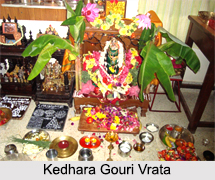 Kedara Gowri (also spelled as Gouri) Vrata is familiarly known as Dipavali or Diwali. People observe this festival with no bar of cast, creed, rich or poor. Very few people know that it is an important Shaivite Vrata. It is celebrated throughout India in a grand manner. Anyone who performed this vrata 21 times will achieve all promising worldly riches and attain liberation at the end. Kedara Gowri Vrata is celebrated on "Ashweeja amavasya". This Vrata is performed by a married couple.
Kedara Gowri (also spelled as Gouri) Vrata is familiarly known as Dipavali or Diwali. People observe this festival with no bar of cast, creed, rich or poor. Very few people know that it is an important Shaivite Vrata. It is celebrated throughout India in a grand manner. Anyone who performed this vrata 21 times will achieve all promising worldly riches and attain liberation at the end. Kedara Gowri Vrata is celebrated on "Ashweeja amavasya". This Vrata is performed by a married couple.
Myths of Kedara Gowri Vrata
There is a legend behind the Kedara Vrata. Bhringi Rishi was a great follower of lord Shiva. He used to pray only to lord Shiva and ignored Shakti. Shakti was very angry by this act and she extracted all the energies from the sage`s body. The rishi was not able to stand any more. He kept continuing his prayer to lord Shiva and God gave him a stick to support his body. Shakti wanted to become a part of lord`s body. She observed the Kedara Vrata, which was one of the God`s favourites. Pleased by Shakti`s austerities, lord Shiva allowed Shakti to become the left part of his body and turned into `Ardhanarishwara` (half god half woman). The Vrata is thereafter called Kedaara Gowri Vrata since goddess Gowri observed it.
Rituals of Kedara Gowri Vrata
The Kedara Gowri Vrata is observed for 21 days starting from Shukla Paksha dashami (tenth Monday of Moon`s growing phase) in the month of Purattachi (mid September to mid October). The final day of this 21 day is Dipavali, which should be observed with great devotion. There are certain rules and mantras to observe this Vrata. Lord Kedharaswami is installed in a filled pot or "kalasham". A roof or "mantapa" is made above the "kalasham". On the Kedara Gowri Vrata day, the devotee must invite a Brahmin and provide him meals.
The Vrata thread is made with 21 fibres with 21 knots. 16 courtesy worships have to be done for 21 days starting from the "Purattachi Dashami" to "Aipachi" (mid October to mid November) "Amarapaksha"/"amavasya Chaturdashi" (Dipavali). The 21st day is the culmination day on which the "kalasham" is installed on a clean decorated area over the grains spread in a banana leaf. The "kalasham" is covered with silk clothes; on which bundle of rice is placed and 21 threads are tied around it. Gold or other precious gems are also placed depending on individual"s affordability. The lord is offered various foods and fruits and poor people are given donations. 21 Brahmins are invited and the devotees present them water and other requirements to clean and appeal to the presence of Lord Kedareswara in the "kalasham". Then the puja is performed on the "kalasham" with "kumkum", sandalwood paste, "akshata", musk, myrrh, and flowers. Special food offerings called as "Naivadya" comprising of 21 varieties of food including coconut are offered to make Lord Shiva happy. After the end of puja, "dakshina" is provided to every Brahmin as per their liking. Sweets and Prasad are also distributed among other devotees and the poor.
Significance of Kedara Gowri Vrata
Kedhara Gouri Vrata is very glorious as Shri Gowri Devi observed the Vrata in full devotion to get assorted in Lord Shiva`s body as Ardhanariswara. As Goddess Parvati observed the Vrata in supreme dedication and got half body of Lord Shiva. Lord Vishnu blessed with Vaikuntha Loka observing Kedara Vrata. Vishnu became Lord of Vaikuntha by observing this Vrata. Brahma got his Hansa vehicle and the guard of eight directions got rid of their curse they got from Brahma. Bhagavati and Punyavati got lots of wealth after performing this Vrata. One who observes this Vrata with devotion pleases Lord Shiva.









